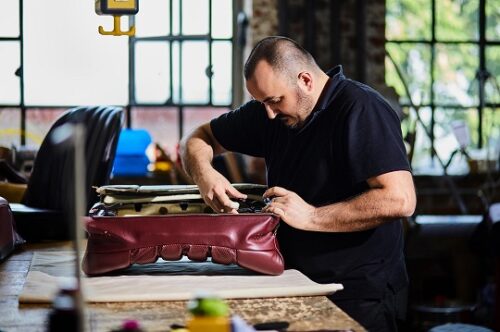8 March 2023
Leather is all around us. It’s in our car seats, upholstery, garments, shoes, and accessories. Not without reason, as leather has been a material we’ve used for millennia. Primitive man hunted animals for food, and the hides were turned into a useful by-product: leather, used for clothing, housing and protection. The ancient Egyptians wore leather sandals. The Greeks developed the first vegetable-based tanning methods to make leather last longer. In our modes of transport and homes, we used leather for its remarkable properties, but how is it actually made? Report by One 4 Leather.

330,000 soccer fields of animal hides
Every year, 2,200 square km of leather is created out of over one billion hides, which the meat industry produces. That’s the equivalent of 330,000 soccer fields or an area slightly smaller than Luxembourg in Europe or Rhode Island in the US. To make leather from these hides, it goes through a process of five steps that is both deeply traditional and hi-tech. Curious? Let’s go through it step by step to see how the leather in our cars is made.
1. Slaughterhouse
There’s no reason to beat around the bush; all the hides we use for leather are a result of food consumption. No surprise then, that the tanning process of leather starts right there, with the leftover hides. These, if not used, would constitute a vast amount of waste and go to. Hides are often cooled, salted, and dried to preserve them, which makes it possible to start tanning them later. Usually, tanneries try to use fresh hides, as this limits the use of resources and the environmental footprint of the process, but this is not always possible as they need to be transported to a tannery. That’s where the real process begins.
2. The Beamhouse
When the hides arrive at the tannery, they enter the beamhouse. Historically, this was a part of the tannery where hides would be strapped over wooden beams for drying. The name just stuck. Nowadays, it’s an integral part of the tannery, where the hide is cleaned and prepared for tanning. This is often an intensive process, involving chemical treatment for dehairing, removing leftover tissue and cleaning the hide. Chemical innovations have made it possible to use more environmentally friendly technologies in this process, even going so far as using biochemistry. This is important, as 70% of water-use in the tanning process takes place in this phase. The pH value of the hide is adjusted, and the protein structure is opened up, ready for the tanning process.
The beamhouse phase is the process that uses the most water for its processes. Modern water management reduces the impact of this process.
3. Tanning
Until this point, we’ve spoken about hides. Tanning is where the protein structure of the hide is changed into a stable material: leather. By tanning the hide, it becomes protected against swelling, heat and micro-organisms, and other decaying factors. Though leather is a long-lasting material, it is still a natural material that can eventually be broken down and fully returned to nature. There are various tanning methods, and those applied are often based on more responsible chemicals, which has helped to reduce the carbon footprint significantly.
Chemical use in tanning is often described as an environmental issue. Responsible and eco-friendly chemistry, however, has changed that.
4. Post-tanning
After tanning the hide, what you have is leather. Yet, it isn’t in the condition yet where it can be used, so it needs a lot of mechanical processing at this phase. Water is removed from the leather through sammying, which is essentially a process involving large rollers that press the water out of the material. Often hides are split at this stage, creating a grain side (the top) and a meat side, which is often used in materials like suede. Finally, the leather is shaved and trimmed to create an even, neat looking material. Often it’s also stretched and flattened out in this process before it goes on towards retanning.
5. Retanning
The leather goes back into the tanning drums for another spin, only this time it is done to give the leather it’s defining characteristics. That means fatliquoring, to improve the softness and strength, but also add waterproof qualities to the material. The leather is also colored, dyed, and treated with other chemicals to make it ready for its final use. What exactly is added depends largely on where the leather will be used. Upholstery requires highly resistant leather, where garments need to be soft and malleable. Automotive leather needs to meet exceptional standards on all fronts, as it will have to resist staining and soiling, but also many environmental factors and daily use.
6. Finishing
After leaving the drums, the leather is finished to give it a final look. Here leather is given a color and matt or gloss finish. Any grain defects or imperfections are fixed with a base coat. A topcoat gives the final touch, and after testing, the leather is good to go. In some cases, the manufacturer of the seats or car upholstery companies takes care of the final finishing of the leather. This allows them to add a specific touch to the interior or customise the looks to meet customer demand. A final treatment with aftercare solutions guarantees a long life for this material.
There you have it, that’s how the leather for your car seat is made! It’s how a from the food industry is turned into a sustainable, durable material to be enjoyed for years.
我们为皮革、物料及时装业界创造面对面洽谈的机会,为客户缔造实质商机。我们云集世界各地的商家,让他们寻找新的合作伙伴,发掘潜在客户或供应商,并掌握业界最新发展。
我们主办多个专注时尚及生活潮流的商贸展览会, 为这不断变化的行业,提供最全面的买家及参展商服务,方便他们了解急速转变的行业环境,并预测来季趋势。

使用条款 | 隐私政策 | APLF 可持续发展